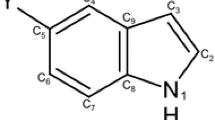Abstract
It has been shown by the CNDO method that the bathochromic shift of the long-wave absorption band in the transition from allylstannane to compounds of the type C=C-C-Sn-X and C=C-Sn-X (where X is a heavy atom) is connected with the formation of a low-energy vacant σ*S-X orbital, localized mainly in the region of the Sn-X chemical bond, and of an occupied σSn-X orbital, the energy of which is somewhat higher than of the σC-Sn orbital. The dependence of the position of the long-wave absorbance region on conformation is related to the fact that, in planar and nonplanar conformers, the long-wave transitions are of a different type (σ → σ* and π → σ*, respectively); the\(E_{\sigma \to \sigma ^ * } trans---E_{\pi \to \sigma ^ * } \) bathochromic shift is determined to a large degree by the difference in the energies of the highest occupied MO (ɛπ - ɛσ) in the s-trans form. In the nonplanar conformers the heavy atom orbitals interact with the π-orbital of the ethylene moiety through the bridge group; this leads to a significant delocalization of the HOMO and to a considerable change in its energy. On the other hand, their interaction with the π*-orbital in compounds of the C=C-C-Sn-X type is very low and does not favor the delocalization of lower vacant MO. In vinyldistannane the π*-orbital is noticeably delocalized, due to the interaction with the π*Sn-Sn orbital in planar and with the σ*Sn-Sn orbital in nonplanar conformers.
Similar content being viewed by others
Literature cited
P. P. Shorygin and B. V. Lopatin,Zh. Fiz. Khim. 42, No. 2, 450 (1968).
K. Ya. Burshtein and P. P. Shorygin,Izv. Akad. Nauk SSSR, Ser. Khim., No. 12, 2764 (1987).
V. M. Promyslov and P. P. Shorygin,Izv. Akad. Nauk SSSR, Ser. Khim., No. 9, 2071 (1991).
M. J. S. Dewar, G. L. Grady, and J. J. P. Stewart,J. Am. Chem. Soc. 106, No. 22, 6771 (1984).
M. J. S. Dewar, E. F. Healy, and J. J. P. Stewart,J. Comput. Chem. 5, No. 4, 358 (1984).
V. M. Promyslov and P. P. Shorygin,Izv. Akad. Nauk SSSR, Ser. Khim., No. 11, 2552 (1989).
Additional information
N. D. Zelinskii Institute of Organic Chemistry, Russian Academy of Sciences, 117913 Moscow. Translated from Izvestiya Akademii Nauk, Seriya Khimicheskaya, No. 3, pp. 636–641, March, 1992.
Rights and permissions
About this article
Cite this article
Promyslov, V.M., Shorygin, P.P. Quantum-chemical study of allylic compounds with two bonded heavy atoms. Russ Chem Bull 41, 500–503 (1992). https://doi.org/10.1007/BF00863072
Received:
Issue Date:
DOI: https://doi.org/10.1007/BF00863072




